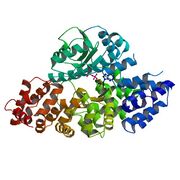What is DRACO?[]
DRACO which stands for Double stranded RNA Activated Caspase Oligomerizer was synthesized in Todd Rider's laboratory from MIT which was published in 2011. It is a novel broad spectrum antiviral protein which has been tested in-vitro and in-vivo against all kinds of enveloped and non-eveloped, DNA and RNA viruses.

Fig1: Mechanism of Action of DRACO Adapted from Science Illustrated
DRACO is a chimera made up of two kinds of proteins: APAF1 and PKR. PKR recognizes double stranded RNA and APAF1 activates the cell's apoptosis pathway. Double stranded RNAs (dsRNA) are unique to only virus infected cells and is absent in normal cells. In other words, when DRACO recognises the same dsRNA two or three times, APAF1 is activated leading to immediate cell death. Viruses usually manipulate proteins early in the apoptotic pathway and not the later ones. This super-protein works because it does not target the virus itself but it signals an infected cell to commit suicide.
DRACO Is made up of PKR and APAF1[]
PKR[]
Protein Kinase R (PKR) is a part of the interferon response pathway. It has an N-terminal domain with two sites for binding dsRNA around 30-50 bases in length (fig1). It has a C-terminal Kinase domain which trans-autophosphorylates itself upon formation of a homodimer leading to self activation and phosphorylation of downstream components like elf2alpha which inhibi

Fig3: PKC annotated using Geneious
ts translation of viral components. It is a higly conserved protein and in humans it is found on chromosome 3 with 19 exons as shown in figure 2.

Fig2: Structure of Human PKR PDB ID: 2A19
APAF1[]
APAF1 stands for apoptotic protease activating factor 1 is one of the downstream proteins in the apoptotic pathway. APAF1 has a caspa

Fig4:Structure of Human APAF1 PDB ID: 1Z6T
se recruitment domain (CARD) and an ATPase domain. Upon binding to cytochrome c and dATP, it forms the apoptosome which enables it to bind and cleave pro-caspase9. This starts a "domino" effect and ultimately causes caspase mediated apoptosis. APAF1 is also highly conserved, especially in primates. In humans, it is found on chromosome 12 with 25 exons as shown in figure4. Figure 3 illustrates the structure of APAF1. In addition to CARD domain from APAF, DRACO also has apoptosis indution domains of FADD and death effector domain to activate procaspase 8.

Fig5:Human APAF1 annotated using geneious
Overview of Experimental Results[]
For efficient delivery and entry into cells, DRACO is fused to transduction tags like HIV TAT and PTD4 (Protein transduction domain 4) in a bacterial expression vector. The protein is purified and then used for both in-vitro and in-vivo studies. The transduction tags enable efficient entry into host cells. Purified DRACO injected into cells with the tags caused cell death only upon injection of dsRNA (ds-double stranded). The cells were normal in the absence of dsRNA and in the presence of DRACO. This indicated that the superprotein is activated only in the presence of dsRNA. Several human cell lines were tested and this result was consistent. DRACO persisted in the cells for about 8 days. DRACO was found to be effective against at least 15 different kinds of viruses including rhinovirus, dengue virus, H1N1 influenza virus, reovirus, adenovirus, arenavirus and bunya virus (refer to table 1). Purified

Table1:DRACO is effective against many viruses. PMID:21818340
TAT-PKR-APAF DRACO injected in mice was present in the liver,kidney and lungs for the first 48 hours. It protected mice against infection with H1N1 influenza when administered intra-nasally. Furthermore trials are required to tease its exact dose and efficacy in humans but it appears to be a very promising tool to treat viral infections in the future.

Fig6: Timeline For DRACO. Adapted from Science Illustrated
Reference:[]
1. Broad-Spectrum Antiviral Therapeutics Rider TH, Zook CE, Boettcher TL, Wick ST, Pancoast JS, et al. (2011) Broad-Spectrum Antiviral Therapeutics. PLoS ONE 6(7): e22572. doi:10.1371/journal.pone.0022572
2. TAT-Mediated Protein Transduction into Mammalian Cells
Michelle Becker-Hapak, Sandra S. McAllister, and Steven F. Dowdy1.
METHODS 24, 247–256 (2001).PMID:11403574
3. http://www.ll.mit.edu/news/DRACO.html
